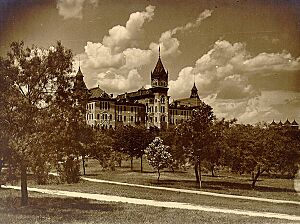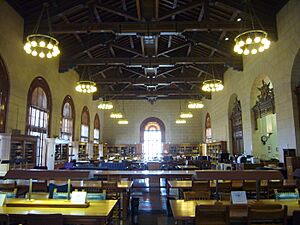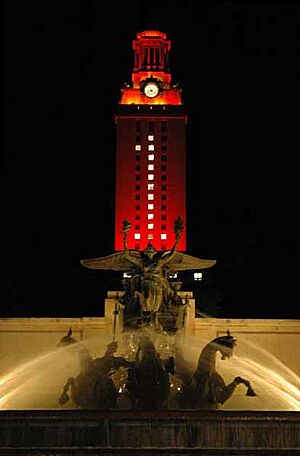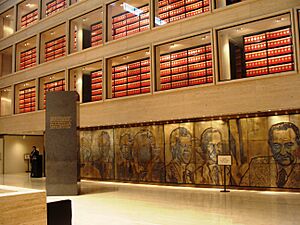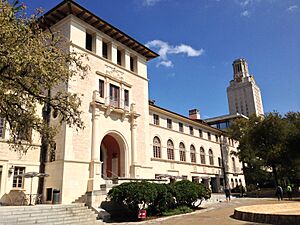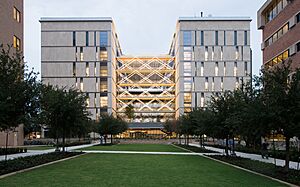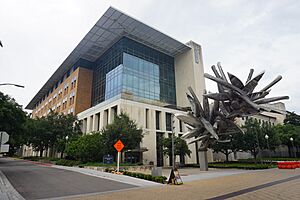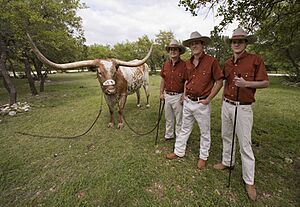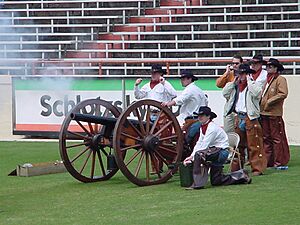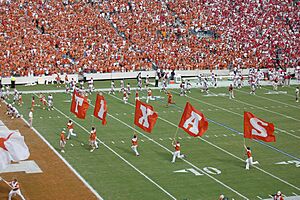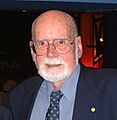University of Texas at Austin facts for kids
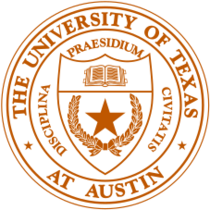 |
|
| Latin: Universitas Texana | |
|
Former names
|
The University of Texas (1881–1967) |
|---|---|
| Motto | Disciplina Praesidium Civitatis (Latin) |
|
Motto in English
|
"Education is the Guardian of the State" |
| Type | Public research university |
| Established | September 15, 1883 |
|
Parent institution
|
University of Texas System |
| Accreditation | SACS |
|
Academic affiliations
|
|
| Endowment | $20.85 billion (FY2024) (UT Austin only) $47.47 billion (FY2024) (system-wide) |
| Budget | $4.35 billion (FY2025) |
| President | Jim Davis |
| Provost | William Inboden |
|
Academic staff
|
4,011 (fall 2023) |
|
Administrative staff
|
2,244 (fall 2024) |
|
Total staff
|
28,761 (fall 2024) |
| Students | 53,864 (fall 2024) |
| Undergraduates | 43,165 (fall 2024) |
| Postgraduates | 10,699 (fall 2024) |
| Location |
,
Texas
,
United States
30°17′06″N 97°44′06″W / 30.285°N 97.735°W |
| Campus | Large city, 431 acres (1.74 km2) |
| Newspaper | The Daily Texan |
| Colors | Burnt Orange and White |
| Nickname | Longhorns |
|
Sporting affiliations
|
NCAA Division I FBS - SEC |
| Mascot |
|
 |
|
The University of Texas at Austin (often called UT Austin, UT, or Texas) is a large public university in Austin, Texas, United States. It was started in 1883 and is the main university in the University of Texas System. With 53,864 students in fall 2024, it is also the biggest school in the system.
UT Austin is a major center for new discoveries and advanced studies. It spends a lot of money on research, totaling over $1 billion in 2023. The university joined a group of top American universities in 1929. It has seven museums and seventeen libraries, including the Lyndon B. Johnson Presidential Library and the Blanton Museum of Art. It also runs special research places like the J. J. Pickle Research Campus and McDonald Observatory, which has powerful telescopes.
The university's sports teams are called the Texas Longhorns. The Longhorns have won many national championships in football, baseball, and swimming. They have won more titles in men's and women's sports than any other school in the Big 12 conference.
Many famous people have been part of UT Austin. As of 2020, 13 Nobel Prize winners, 25 Pulitzer Prize winners, and many other award winners have been connected to the school as students, teachers, or researchers. Its students and alumni have also won a total of 155 Olympic medals.
Contents
The University's Story
How UT Austin Began
The idea for a public university in Texas first appeared in 1827, even before Texas was its own country. After Texas became independent in 1836, its leaders promised to create a system for public education.
In 1858, money was set aside to start the University of Texas. However, a big war delayed these plans. By 1876, the Texas Constitution made it clear that "The University of Texas" must be built.
On March 30, 1881, people voted on where the university should be. Austin was chosen as the main campus, and Galveston was picked for the medical school. The first building, called Old Main, had its cornerstone laid in 1882. The University of Texas officially opened its doors on September 15, 1883.
Growing and Changing Over Time
The first Old Main Building was built in an old-fashioned, grand style. It was the main spot on campus for many years. But by the 1930s, the university needed more space for its library. So, the Old Main Building was taken down in 1934, even though many students and teachers didn't want it to be. The tall tower and new Main Building that you see today were built in its place.
In 1916, a disagreement happened between the Texas Governor and the university about hiring teachers. The Governor tried to stop the university's budget, but he was later removed from his job for misusing public money.
In 1923, oil was found on land owned by the university. This discovery brought a lot of money to a special fund called the Permanent University Fund. This extra money helped the university grow and build new facilities. In 1929, the University of Texas joined the Association of American Universities, a group of top universities.
During World War II, UT Austin helped the country by training Navy students. After a big court decision in 1954, the university started to change its rules. By 1956, the first Black students joined the undergraduate classes. The university fully welcomed all students into its facilities and dorms by 1965.
In 1965, the Texas Legislature allowed the university to buy more land around its campus to help it grow. On March 6, 1967, the university's official name was changed to "The University of Texas at Austin" to show how much it had expanded.
Important Moments and Recent Years
In 1966, a tragic event occurred at the university tower. After this sad event, the observation deck was closed for safety reasons. It reopened in 1999 with new security measures. There is a special pond park near the tower dedicated to those affected by the tragedy.
The first presidential library on a university campus, the Lyndon B. Johnson Presidential Library, was opened in 1971. It holds important documents and items from former President Johnson's time in office.
A statue of Martin Luther King Jr. was placed on campus in 1999 to honor his work for civil rights.
The university has added many new buildings recently. In 2006, the Blanton Museum of Art opened. In 2008, the AT&T Executive Education and Conference Center was completed, and the Darrell K Royal-Texas Memorial Stadium was expanded to hold over 100,000 fans.
In 2010, another sad event took place at the Perry–Castañeda Library, leading to the death of one student. No other students were harmed.
The university adjusted to the COVID-19 pandemic in 2020 by moving classes online and offering free tests. By fall 2021, most classes returned to in-person learning with safety rules.
In 2024, the university brought back mandatory standardized testing scores (like the SAT and ACT) for students applying for fall 2025. The university's president said these tests help find the best students.
In April 2024, the university made some changes to its programs to follow new state laws. This included changes to how it supports diversity and community engagement.
In April 2024, students and faculty held protests on campus to share their views on important global issues. The university worked with local police to manage the protests and ensure safety on campus. The university also updated its rules for protests on campus, including guidelines for masks and curfews.
In April 2025, the University of Texas at Austin changed some graduation requirements, including certain "Flag" courses related to cultural diversity.
Exploring the Campus
The university owns a total of 1,438.5 acres (582.1 ha) of land. This includes the main campus in central Austin, which is 423.5 acres (171.4 ha), and the J. J. Pickle Research Campus in north Austin. The main campus has 150 buildings that cover a huge area of over 18,000,000 square feet (1,700,000 m2).
One of the most famous parts of the university is its Main Building, which has a tall tower. The tower is 307-foot (94 m) high and was finished in 1937. It usually glows with white light at night, but it turns burnt orange for special events like sports victories or academic achievements. It is darkened for sad occasions. At the top of the tower are 56 bells, which play songs on weekdays and chime every 15 minutes. The observation deck at the top of the tower reopened for public tours on weekends in 1998.
The university's seven museums and seventeen libraries hold over nine million books and other materials, making it one of the largest academic libraries in the country. The Harry Ransom Humanities Research Center has very rare items, like one of the few remaining copies of the Gutenberg Bible and the world's first permanent photograph. The Blanton Museum of Art is the largest university art museum in the United States, with about 17,000 artworks. The Perry–Castañeda Library is the main library on campus, and the Benson Latin American Collection has the biggest collection of Latin American materials among U.S. university libraries.
Underneath the campus, there is a network of tunnels about six miles long. These tunnels are used for communications and utilities. They are closed to the public and protected by security systems. Since the late 1940s, the university has generated its own electricity. It also operates a small nuclear reactor at the J. J. Pickle Research Campus.
The university continues to build new facilities. In 2010, the Norman Hackerman building opened for chemistry and biology research. The environmentally friendly Student Activity Center (SAC) opened in 2011, offering study rooms, lounges, and food. In 2012, the Moody Foundation gave $50 million to the College of Communication, which was then named the Moody College of Communication.
The university also runs two public radio stations, KUT for news and KUTX for music. Students can ride public buses around campus and Austin for free with their university ID.
How the University is Organized
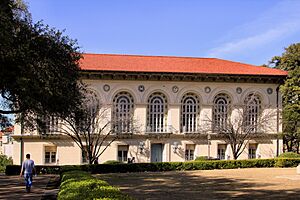
The University of Texas at Austin has nineteen colleges and schools, each focusing on different subjects. Here are some of them:
- School of Civic Leadership (2023)
- Cockrell School of Engineering (1894)
- Dell Medical School (2013)
- College of Education (1905)
- College of Fine Arts (1938)
- College of Liberal Arts (1883)
- College of Natural Sciences (1883)
- College of Pharmacy (1893 in Galveston, moved to Austin 1927)
- Continuing Education (1909)
- Graduate Studies (1910)
- Jackson School of Geosciences (2005)
- LBJ School of Public Affairs (1970)
- McCombs School of Business (1922)
- Moody College of Communication (1965)
- School of Architecture (1948)
- School of Information (1948)
- School of Law (1883)
- School of Nursing (1976)
- School of Undergraduate Studies (2008)
- Steve Hicks School of Social Work (1950)
Learning at UT Austin
The University of Texas at Austin offers many different study programs. Students can choose from over 100 undergraduate degrees and 170 graduate degrees. In the 2009–2010 school year, the university awarded over 13,000 degrees, with most being bachelor's degrees.
The university also has nine special honors programs for students who want an extra challenge. These programs cover many subjects, from liberal arts to computer science and nursing. There's also the Plan II Honors Program, which is a unique interdisciplinary program.
How to Get In
| Admissions statistics | |
|---|---|
|
2021 entering
classChange vs. 2016 |
|
| Admit rate | 35.4%
(
|
| Yield rate | 47.7
(
|
| Test scores middle 50% | |
| SAT Total | 1230–1480 (among 56% of FTFs) |
| ACT Composite | 29–34 (among 26% of FTFs) |
UT Austin encourages students to submit their SAT or ACT scores. For students applying for fall 2025 and later, these scores are a required part of their application. The university is known for being one of the most selective schools in Texas.
Texas law helps students who do very well in high school get into public universities. For UT Austin, a certain percentage of the top students from Texas high schools are automatically accepted. However, even with automatic admission, students are not guaranteed their first choice of major or college within the university.
For other applicants, getting into UT Austin is considered "more selective." For fall 2023, about 66,000 students applied, and about 19,000 were accepted. Of those accepted, nearly half chose to enroll. Many of the freshmen who enrolled in fall 2024 were in the top 10% of their high school classes.
| 2021 | 2020 | 2019 | 2018 | 2017 | 2016 | |
|---|---|---|---|---|---|---|
| Applicants | 66,043 | 57,241 | 53,525 | 50,575 | 51,033 | 47,511 |
| Admits | 18,989 | 18,291 | 17,029 | 19,482 | 18,620 | 19,182 |
| Admit rate | 28.8 | 32.0 | 31.8 | 38.5 | 36.5 | 40.4 |
| Enrolled | 9,060 | 8,459 | 8,170 | 8,960 | 8,381 | 8,719 |
| Yield rate | 47.7 | 46.2 | 48.0 | 46.0 | 45.0 | 45.5 |
| ACT composite* (out of 36) |
29–34 (26%†) |
26–33 (47%†) |
27–33 (54%†) |
27–33 (56%†) |
26–33 (65%†) |
26–32 (64%†) |
| SAT composite* (out of 1600) |
1230–1480 (56%†) |
1220–1450 (79%†) |
1240–1470 (79%†) |
1230–1480 (78%†) |
1230–1460 (73%†) |
— |
| * middle 50% range † percentage of first-time freshmen who chose to submit |
||||||
University Rankings
The University of Texas at Austin is highly ranked among universities. U.S. News & World Report ranked it 30th among all universities in the U.S. and 7th among public universities for 2025.
Globally, UT Austin was ranked 56th by U.S. News & World Report in 2024, 45th by the Academic Ranking of World Universities in 2024, and 52nd by Times Higher Education World University Rankings in 2024. It was also ranked 66th globally by QS World University Rankings for 2025.
UT Austin is often called a "Public Ivy" because it offers a top-notch education similar to private Ivy League schools, but at a public university price.
Many of its programs are ranked among the best in the nation. For example, its accounting and Latin American history programs are consistently ranked number one. Over 50 other science, humanities, and professional programs are in the top 25 nationally.
Research and Discoveries
UT Austin is known as a top university for research. For the 2014–2015 year, it received over $580 million for research projects and has earned more than 300 patents since 2003. The university helps turn new lab discoveries into useful products and has created many new companies based on its research.
Research at UT Austin focuses a lot on engineering and physical sciences, especially computer science. Energy research is also a big area, with projects on biofuels, battery technology, and solar cells. In 2009, the university started the Energy Institute to bring together different energy research efforts. It also has medical programs and research in pharmacy, biomedical engineering, and neuroscience.
In 2010, the Dell Pediatric Research Institute opened to boost medical research at the university.
The university runs several important research centers. The McDonald Observatory, located far west of Austin, has the world's third-largest telescope. The Brackenridge Field Laboratory is used for biological studies. The J.J. Pickle Research Campus (PRC) is home to powerful supercomputers and a special cleanroom for making tiny electronic devices.
The Applied Research Laboratories at the PRC have helped develop sonar equipment for the Navy. The Institute for Advanced Technology supports the U.S. Army with research. The Center for Transportation Research studies many aspects of transportation, from traffic to new materials.
In 2013, the O'Donnell Foundation gave over $135 million to the university to support research in math, computers, and science. In 2023, UT Austin and Amazon also created a new science hub together.
The University of Texas at Austin Marine Science Institute, located on the Gulf Coast, studies marine ecosystems and global ocean issues.
University Funding
The University of Texas System gets money from a special fund called the Permanent University Fund (PUF), which had over $33 billion in assets in 2021. This fund shares its income with the University of Texas System and the Texas A&M University System. A large part of this money goes to UT Austin to help improve its programs.
The PUF gets its money from lands given to the university long ago, as well as from oil found on those lands. While it used to be the main source of income, today it accounts for less than 10% of the university's yearly budget. This means the university also relies on research grants and private donations.
Life as a Student
| Race and ethnicity | Total | ||
|---|---|---|---|
| White | 32% |
|
|
| Hispanic | 28% |
|
|
| Asian | 25% |
|
|
| Black | 5% |
|
|
| International student | 4% |
|
|
| Two or more races | 4% |
|
|
| Unknown | 2% |
|
|
| Economic diversity | |||
| Low-income | 25% |
|
|
| Affluent | 75% |
|
|
Who Studies Here?
In fall 2024, UT Austin had 43,165 undergraduate students and 10,699 graduate students, making a total of 53,864 students. About 9% of students came from other states, and another 9% were international students from other countries.
In 2022, the most popular undergraduate majors were Biology, Psychology, and Computer Science. For graduate students, Business Administration, Accounting, and Management were top choices.
Living on Campus
The campus has fifteen residence halls where students can live. The newest one opened in spring 2007. These dorms can house over 7,100 students. Jester Center is the largest dorm, with space for 2,945 students. Because so many students attend, many also live in private dorms, apartments, or with student groups off campus.
Student Groups
UT Austin has a very active Greek community, with about 14% of undergraduate students joining fraternities or sororities. There are more than 65 national chapters, making it one of the largest Greek communities in the country. Most of these houses are located near campus in the West Campus neighborhood.
Student News and Media
Students at UT Austin can share their voices through various media. This includes Study Breaks magazine, Longhorn Life, and The Daily Texan, which is a highly awarded college newspaper. Students also run their own TV station, Texas Student Television, and radio station, KVRX Radio.
University Traditions
UT Austin has many fun traditions. At sports events, students often sing "Texas Fight", the university's fight song. They also show the Hook 'em Horns hand gesture, which looks like the horns of the school's mascot, Bevo the Texas Longhorn.
Smokey the Cannon
The university is also represented by the Texas Cowboys, a student group that takes care of Smokey the Cannon. Smokey is a replica of a 1,200-pound Civil War cannon that is fired during football games.
Sports at UT Austin
The University of Texas offers many sports programs, both for varsity teams and for students to play for fun.
Varsity Sports Teams
The university's men's and women's sports teams are called the Longhorns. Texas has won 50 national championships, with 42 of them being NCAA national championships.
The football team had great success under coach Darrell Royal, winning three national championships in 1963, 1969, and 1970. They won another title in 2005 under coach Mack Brown.
The university's baseball team has been to the College World Series more than any other school and won championships in 1949, 1950, 1975, 1983, 2002, and 2005.
The Texas Longhorns men's basketball team has reached the NCAA Final Four three times and won many conference championships.
The men's and women's swimming and diving teams have won sixteen NCAA Division I titles, with the men's team winning 13 of those.
In 2020, UT student-athletes spoke up about important issues, asking for changes like renaming certain campus buildings and honoring Black students and athletes. The university responded by making multi-million dollar investments to support Black students, renaming buildings, and commissioning new monuments.
Famous People from UT Austin
Teachers and Researchers
In fall 2016, the university had 3,128 full-time teachers. These teachers include winners of the Nobel Prize, Pulitzer Prize, and many other important awards. Nine Nobel Prize winners have been connected to UT Austin. The university spent over $679.8 million on research in 2018.
Alumni (Former Students)
Texas Exes is the official group for former students of the University of Texas. The Alcalde is the university's alumni magazine, started in 1913.
Alumni in Government
Many UT Austin graduates have worked in government. At least 15 have served in the U.S. Senate or House of Representatives. Former U.S. cabinet members include Rex Tillerson and James Baker. Former First Ladies Laura Bush and Lady Bird Johnson also graduated from Texas.
In other countries, former students include Fernando Belaúnde Terry, who was President of Peru, and Salam Fayyad, who was Prime Minister of the Palestinian National Authority.
Alumni in Academia
Former students in academia include Nobel Prize winners James P. Allison (immunologist) and E. Donnall Thomas (hematologist). Other alumni have become presidents of major universities. Alan Bean, the fourth person to walk on the Moon, also graduated from UT Austin.
Alumni in Business
Business leaders who attended UT Austin include Dell founder Michael Dell, former ExxonMobil Corporation CEO Rex Tillerson, and former Southwest Airlines CEO Gary C. Kelly.
Alumni in Writing and News
In writing and journalism, the school's alumni and teachers have won over 25 Pulitzer Prizes. Famous journalists like Walter Cronkite and Betty Nguyen attended the university. Novelist J. M. Coetzee won the 2003 Nobel Prize in Literature. Raymond Benson was the official author of James Bond novels for a time.
Alumni with Scholarships
UT Austin alumni have earned many prestigious scholarships, including 112 Fulbright Scholars, 31 Rhodes Scholars, and 23 Marshall Scholars. Nine astronauts are also alumni.
Alumni in Music and Entertainment
Many musicians and entertainers attended the university. Singer Janis Joplin and actress Jayne Mansfield were students. Film director Robert Rodriguez and actors Eli Wallach and Matthew McConaughey are Longhorns. Matthew McConaughey now teaches a class at the university.
Other notable alumni include Felicia Day (actress), Renée Zellweger (actress), Owen Wilson (actor), and Wes Anderson (writer/director). Farrah Fawcett, one of the original Charlie's Angels, also attended.
Alumni in Sports
Many alumni have become successful professional athletes. Legendary football coach Tom Landry played for the Longhorns. Seven-time Cy Young Award winner Roger Clemens played baseball for Texas. NBA MVP Kevin Durant and golfer Jordan Spieth are also alumni. Scottie Scheffler, a Masters Tournament champion, also attended.
Several Olympic medalists have attended the school, including swimmers Ian Crocker and Garrett Weber-Gale, and track star Sanya Richards-Ross. Gymnast Mary Lou Retton, a five-time Olympic medalist, also attended. Robert Cade, the inventor of the sports drink Gatorade, is an alumnus.
Other Notable Alumni
Other famous alumni include businessman Red McCombs, astrophysicist Neil deGrasse Tyson, and Admiral William H. McRaven, who led the mission that found Osama bin Laden. Oveta Culp Hobby, the first woman to earn the rank of colonel in the U.S. Army, also attended.
Images for kids
-
James P. Allison, Nobel Prize-winning immunologist
-
Wes Anderson, Academy Award-winning director
-
James Baker, former White House Chief of Staff and Secretary of State
-
Tom C. Clark, Attorney General and Associate Justice of the Supreme Court
-
J. M. Coetzee, novelist and Nobel laureate
-
Kevin Durant, 14-time NBA All-Star
-
Matthew McConaughey, Academy Award-winning actor
-
Scottie Scheffler, professional golfer
-
Jordan Spieth, professional golfer
-
E. Donnall Thomas, Nobel Prize-winning hematologist
-
Rex Tillerson, Secretary of State
-
Neil deGrasse Tyson, astrophysicist
-
Owen Wilson, actor
See also
 In Spanish: Universidad de Texas en Austin para niños
In Spanish: Universidad de Texas en Austin para niños
- Silicon Hills
- University of Texas at Austin High School
- University of Texas Elementary School


